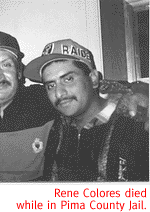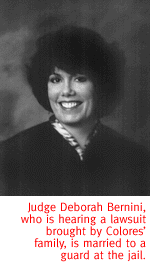
...It's Not Usually Meted Out For Shoplifting, But Rene Colores Got It Anyway.
By Chris Limberis
RENE COLORES IS neither an angel nor the devil. He is,
however, dead.
Messed up on his final dose of smack and drowning in his own
phlegm, Colores was vomiting, coughing and writhing as his sad
life ended at age 22 in the Pima County Jail on April 23 last
year.
Now his father, Raymond Colores, wants money--big money--from
the county and the city, whose police officers arrested his son
for shoplifting at Tucson Mall the day before he died of bilateral
bronchopneumonia.
 Raymond Colores knows about loss. His wife is dead. A daughter
is dead. And he gets around in a wheelchair because diabetes has
taken his legs.
Raymond Colores knows about loss. His wife is dead. A daughter
is dead. And he gets around in a wheelchair because diabetes has
taken his legs.
His boy, Rene, liked heroin. Born in Los Angeles, he moved to
Tucson four years ago. He did not work. Sometimes he went by the
name Rudy Padilla. Other times, Negro. To support his habit, police
say, Rene Colores stole. The day before he died, he lifted clothes
at Dillard's that he planned to sell to support a drug habit that
ran to $175 a day. Three months earlier he was arrested for stealing
a car. He was in and out jail and residential drug treatment.
He'd been living in rehabilitation at Victory Outreach after Pima
County Pretrial Services recommended that he be released from
jail in March 1997 following the auto theft arrest.
Now Raymond Colores has a lawyer. William B. Lucas, a former
Bullhead City prosecutor and an assistant city attorney in Denver,
filed suit against the city and county on behalf of Raymond Colores
almost a year after his son died.
Lucas says Rene Colores' pleas for medical help were ignored
and that the lack of adequate medical attention led to Rene Colores'
death. Lawyers for the city and county, in recent responses, deny
police or jail officials did anything to contribute to Rene Colores'
death.
There are 27 divisions and judges in Pima County Superior
Court. The Colores case landed before Judge Deborah Ann Bernini,
who has yet to recuse herself despite being married, since March
22, 1996, to Frank F. Obregon, a jail corrections officer for
the past 14 years.
The lawsuit also is raising serious questions about conflicts
between the court and jail when inmates are sick. Colores was
hacking, throwing up and in pain while at the jail. Even jail
officials say that inmates and others noted the overwhelmingly
foul smell of his severe infection.
 Arizona criminal procedure requires people who are arrested to
have their initial appearance before a judge or magistrate within
24 hours of arrest. Release is required if the deadline is not
met. Colores, jail documents show, was in the medical line waiting
to see a doctor when he was called to get in the court line. Most
initial appearances and arraignments are done via a video-audio
linkup between the court and the jail.
Arizona criminal procedure requires people who are arrested to
have their initial appearance before a judge or magistrate within
24 hours of arrest. Release is required if the deadline is not
met. Colores, jail documents show, was in the medical line waiting
to see a doctor when he was called to get in the court line. Most
initial appearances and arraignments are done via a video-audio
linkup between the court and the jail.
Michael J. Brown, the presiding judge of Superior Court and an
official who is usually unavoidable for comment, refused to discuss
those procedures and conflicts arising out of inmate medical cases.
Designed for 1,147 people, but containing a daily average of
1,339, Pima County Jail is overcrowded and busy. The frenetic
intake area is a mill for nearly 80 new inmates a day. And they're
not a healthy lot. Many are like Rene Colores: sick, drug-addicted
and uninsured. In fact, once incarcerated, everyone is uninsured.
Richard Boykin is a former Pima County sheriff who's now in charge
of the jail.
"These people are not like most of the rest of society,"
Boykin said. "We get a population that's not in the best
of health. Many have severe drug problems. Many have severe infections.
Unfortunately, we get people in bad, bad shape. In this particular
case, he was filled with infection."
The jail's medical unit, operating on a budget of $1.7 million
this year, has a doctor and 15 nurses. A chief nurse-practitioner
typically sees 20 inmate patients a day. Medical costs are down
at the jail, which in some years has seen costs jump dramatically
with just a single operation, such as heart surgery.
Colores was the second sick inmate to die after incarceration
at the jail in the last 16 months. Jerry James, a 300-pound 29-year-old
died December 26, 1996. He also had severe pneumonia, according
to an autopsy report. The difference in the James case is that
with his severe fever--104--James was sent by a jail nurse on
Christmas to the county's Kino Community Hospital. But Kino sent
James back without doing a chest X-ray or any lab work. James'
next stop, like Colores', was St. Mary's Hospital, where he died.
It's up to plaintiff's attorney Lucas to find out how Colores
slipped through the cracks.
Assistant City Attorney Michael Owen, in his motion asking Judge
Bernini to dismiss the city as a plaintiff, says the city had
no duty to provide medical care to Colores. Two similar affidavits
from city cops James Stoutmeyer and Mark Cassel portray Colores
as an admitted "heroin addict or junkie."
At about 2:30 p.m. on April 22 last year, Stoutmeyer arrested
Colores, who also had an outstanding warrant on the previous auto
theft charge. Stoutmeyer said that Colores admitted he'd last
shot up at about noon. Asked about his condition when he coughed,
Colores, according to the cops, said he was coming down with a
cold.
Lucas said Colores either never said he was on heroin or said
it "just to jack up the police."
Lucas casts doubts about the cops' statements and questions who
wrote the affidavits.
 Colores, a slight person at 5-foot 4-inches and 115 pounds, was
booked into the jail at 5:39 p.m. He was coughing and vomiting
for hours, Lucas says. He begged for medical attention. Finally
seen by a nurse or nursing assistant, Colores was given a dose
of Mylanta and told to lie down. Later, Lucas said, Colores was
moved to another cell so he would not bother a cellmate. He was
given a wastebasket to catch his vomit, but he was given nothing
to combat his dehydration.
Colores, a slight person at 5-foot 4-inches and 115 pounds, was
booked into the jail at 5:39 p.m. He was coughing and vomiting
for hours, Lucas says. He begged for medical attention. Finally
seen by a nurse or nursing assistant, Colores was given a dose
of Mylanta and told to lie down. Later, Lucas said, Colores was
moved to another cell so he would not bother a cellmate. He was
given a wastebasket to catch his vomit, but he was given nothing
to combat his dehydration.
An internal sheriff's memo states Colores was in line at 10 a.m.
on April 23 to see a doctor. But he was called out for his initial
appearance and was placed in the doctor's schedule for the next
day. But by 3:48 p.m., he was dead.
The autopsy the following day said: "There are no definite
identifiable needle tracks in Colores' heavily tattooed arms."
But subsequent lab tests showed opiates and marijuana in Colores'
urine.
Lucas calls the autopsy report "contradictory." He
also questions the relevance of drug-use evidence in this case.
"I'm not so sure it matters," Lucas said. "Does
it mean that somebody on drugs doesn't deserve medical attention?"

|





